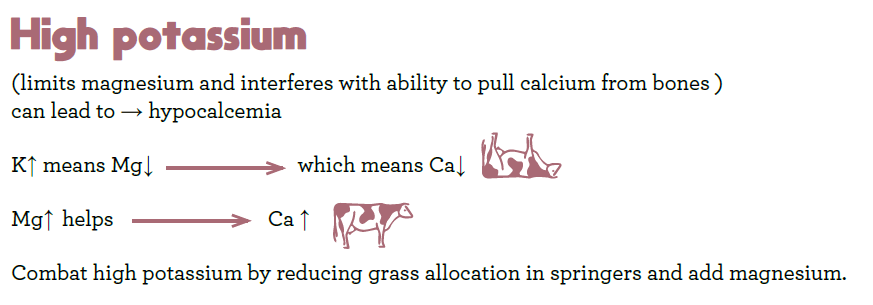Adjusting feed can alter the pH of your affected cow’s blood, explains Dr Jim Gibbs. Anne Lee reports.
If milk fever is an issue there are two or three more important factors you should look to before going down the, often expensive, route of using anionic solutions and treating it as a dietary cation anion difference (DCAD) problem.
Lincoln University senior lecturer and veterinary scientist Dr Jim Gibbs explains that DCAD refers to the difference between the positive cations and negative anions in the feed.
By altering the feed so the difference is slightly negative it’s possible to alter the pH of the animal’s blood which in turn helps the natural parathyroid hormone system to pull calcium out of the bones – necessary post calving when the cow begins lactating and there’s a huge increase in the need for calcium.
Managing blood pH to reduce hypocalcemia (milk fever) using feed can be effective in total mixed ration (TMR) diets but in New Zealand’s pasture-based system it’s virtually impossible.
Overseas studies show the best way to control DCAD is to limit potassium (K+) at 1% of drymatter (DM) and sodium (Na²+) at 0.1%.
“That’s impossible for us in our pasture-based system. Our grass often has K levels above 3%DM and can have Na levels at 1% – so we have a lot of positive cations to contend with that TMR systems don’t have.”
“The only way we’re going to get DCAD at the slightly negative level is to feed something with a lot of negatives and all we have available in our feeds are chlorine (Cl¯), phosphorous (P³¯) and sulphur (S²¯).
“You can’t feed a lot of these – or certainly not the amount that would be needed to offset the K and Na without causing other major health problems or worse.
“People do turn to anionic salts but you have to feed a lot of them – and they’re expensive – but it’s still almost impossible to get around the amount of K in the grass so to do it properly you really need to be feeding them what amounts to a total mixed ration for the springer mob for up to a couple of weeks.
“To be frank – even if you could get it completely right the relative significance of DCAD in preventing milk fever here is several steps down the list.
“We have other factors at play. In almost every instance where I’ve been called out to a train wreck when it comes to milk fever it’s never yet been because of DCAD.
“It will be because cows are fat or that springer ration hasn’t been managed well and there’s just too much grass in the daily diet so the K is high and/or something’s gone wrong with getting the magnesium into them.
“Our issue with high K isn’t DCAD, it’s because it’s blocking the magnesium uptake and we use magnesium to get that parathyroid hormone system working to pull the calcium out of the bones.”
In terms of rankings, Jim says its:
- Get body condition score (BCS) right.
- Make sure there’s enough magnesium going to springers.
- Have enough metabolisable energy (ME) for maintenance or just under, for the springer ration.
Farmers are generally managing cows going into winter better and feeding them well over winter but they can have too much of a good thing and more cows are hitting calving at BCS 5 or more than in the past.
MONITOR YOUR COWS
Monitoring cows through autumn and winter and making sure they’re in mobs of similar BCS going into winter so feed allocation can be well managed is important.
“Now we’re in spring the big issue is pre-calving, springer management.
“Get cows off beet 10 days before calving and manage their feed allocation, especially their access to grass because it’s high in K.
Hay, straw and silage are all lower in K, and ME, so help keep both magnesium and ME intakes down in the springer ration.
“As long as they’re getting maintenance or just under – which is going to be about 90-100 megajoules (MJ) of ME per cow per day for that typical Kiwi-cross animal they’ll be ok.”
The temptation in a year where there’s been good grass growth through the winter is to increase the pasture allocation and dial down the straw or hay for springers but that’s a recipe for disaster, he says.
Pay close attention to getting enough magnesium into cows through the springer period.
“It won’t be a perfect science but getting causmag across their feed has to be done well every day.”
Can you give them too much magnesium?
No, very unlikely, Jim says.
There are claims for excess magnesium associated with sporadic Salmonella outbreaks, but given most of the South Island feeds it above the level claimed, clearly it is not the primary driver.
Cows will just pee out what they don’t need and at very high doses it may cause some diarrhoea and can act like lithium for cows causing them to be slow and “chilled out”.
Once calved, supplementing the diet with calcium – often through lime flour application to feed, will help boost calcium levels but keep going with the magnesium too.
Once they’re 72 hours post calving you’re usually out of the danger zone and the parathyroid hormone system has kicked in well but Jim says most farmers will keep magnesium going in through the water – which they’ll start to drink more of once milking – until December and some right through the season. If you are removing it, do it gradually, don’t just stop overnight, he says.




